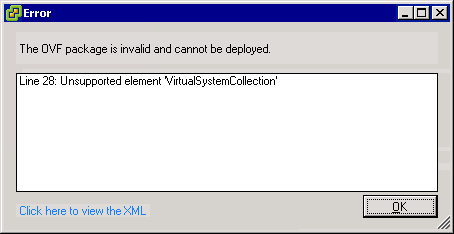Unsupported element 'VirtualSystemCollection' + how to split an OVA
A colleague recently stumbled upon this beautiful error when trying to import an OVA to an ESX and ESXi host:

The cause is that the packaged OVA is actually a vApp extract from vCenter, and standalone hosts (not under management of a vCenter) are not able to accomodate vApp.
From VMware
vApps: Ensuring seamless application movement and choice between clouds
It seems a single host isn’t “cloud”-enough. 😉
An OVA that is extracted from vCenter which contains only a single VM is extremely close in its structure to the OVF apart from a tuple called … *drum roll* … <VirtualSystem ovf:id="cake"> in the single, and <VirtualSystemCollection ovf:id="cake"> in one that encompasses multiple machines. So a hosts ability is limited to not being able to parse this collection of machines and discriminate between their properties, that’s why you need to spend $ on vCenter!
This is all great, but my colleague is now stuck half-way around the world with a set of machines that need to be deployed on a single host, and all of them are saved within this OVA.
An OVA is just a wrapper for an OVF (think VMX) and some VMDK’s {anyone VM/OVconfused yet?}.
$ tar tf cake.ova
cake.ovf
cake-disk1.vmdk
cake-disk2.vmdk
cake-disk3.vmdk
cake-disk4.vmdk
cake-disk5.vmdk
cake.mfWe can see there’s a collection of VMDK’s, the manifest which inside looks like this:
SHA1(cake.ovf)= 03AD765EC45B90E13BC22D0115088F08021F2AE5
SHA1(cake-disk1.vmdk)= 92BB519FD1926D4F3C170C727C037E2D5D79775B
… and more importantly the OVF, which describes the OVA motherload.
My thoughts were at first to just create a VMX for each of the VMDKs and then I can go to bed. Unfortunately one of the machines has two disks, so the first issue is with figuring out how the OVF nests the rasd - Resource Allocation Setting Data (as per the DMTF OVF Specification V1.1).
Thanks to Mr. Pekka for writing xmlindent or you could just use the online version
I was quickly able to see to which VM disks 3+4 belonged to, and create the appropriate VMX skeleton. Now if only there was a parser…